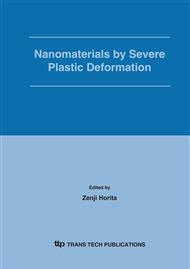p.913
p.919
p.925
p.931
p.937
p.943
p.949
p.955
p.961
An EBSD Study of Texture and Grain Boundary Evolution in a Strongly Textured Aluminium Alloy during ECA Pressing
Abstract:
The texture and grain boundary evolution during equal channel angular pressing (ECAP) of a spray-cast Al-7034 (Al-Zn-Mg-Cu) alloy containing intermetallic particles with a range of sizes was studied through electron backscatter diffraction (EBSD). Up to 8 passes of ECAP using route Bc were employed. The initial ECAP pass leads to the development of low angle grain boundaries and subsequent passes lead to a relatively rapid increase in the fraction of high angle grain boundaries. Before ECAP, the material possessed a strong <111> and <100> fibre texture. On ECAP, the <111> fibre texture component is mostly retained but the <100> fibre develops to a Cube texture after the first ECAP pass. Goss textures form from about 4 passes of ECAP.
Info:
Periodical:
Pages:
937-942
Citation:
Online since:
January 2006
Authors:
Price:
Сopyright:
© 2006 Trans Tech Publications Ltd. All Rights Reserved
Share:
Citation:


